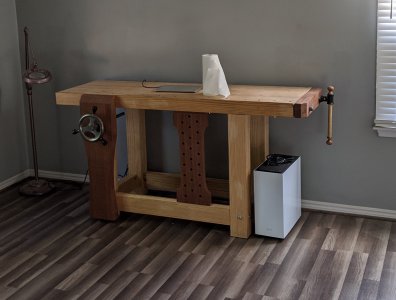-
Welcome back Guest! Did you know you can mentor other members here at H-M? If not, please check out our Relaunch of Hobby Machinist Mentoring Program!
You are using an out of date browser. It may not display this or other websites correctly.
You should upgrade or use an alternative browser.
You should upgrade or use an alternative browser.
Laminated 2x4 Bench Top?
- Thread starter Chips O'Toole
- Start date
- Joined
- Jan 5, 2014
- Messages
- 943
I made a top years ago out of pallet wood. Mainly oak hardwood pallets from work. It is still in use. About 2" thick and 3 Ft x 7 Ft. It is a heavy beast. I used gorilla glue for the first time and loved it. I leveled the top using a router mounted to a board and ran it back and forth over some straight edges. Fun project and I liked saving the pallets that were otherwise being tossed.
![20221006_142258[1].jpg 20221006_142258[1].jpg](https://www.hobby-machinist.com/data/attachments/379/379747-a7a952caa7adae066cf9d94a5e13f5d2.jpg)
![20221006_142258[1].jpg 20221006_142258[1].jpg](https://www.hobby-machinist.com/data/attachments/379/379747-a7a952caa7adae066cf9d94a5e13f5d2.jpg)
Last edited:
- Joined
- Jun 15, 2017
- Messages
- 525
Don't worry. The jointer and planer will fix everything fast.If you're in the US just make sure you realize 2x4's in the US have rounded corners. They will need to be removed to get a flat table top. It's a lot of work with a hand plane. Also 2x4s aren't usually great wood. You're better off buying 2x12 and cutting 2x4s out of each side and throwing away the pith in the middle.
I use these spring loaded bench dogs for the holes that pass through to the legs on my bench.
 www.leevalley.com
www.leevalley.com
Would be pricey if you wanted to fill a hole table with them. But this is a machining site after all, you could set up to do a small production run and make your own. I think the spring is a little too light in the lee valley version anyway.
Veritas Prairie Dog - Lee Valley Tools
Would be pricey if you wanted to fill a hole table with them. But this is a machining site after all, you could set up to do a small production run and make your own. I think the spring is a little too light in the lee valley version anyway.
- Joined
- Oct 11, 2016
- Messages
- 3,860
+1My "go to" bench is double 3/4 ply with 2x4 frame under.
I built a bunch of benches for metalworking over 40 years ago, and they were 2 layers of 3/4" plywood glued with yellow glue, screwed together on 12" intervals, then filled in to 6" intervals. Screws removed, then 3/4" maple flooring was glued down. I took it to a big woodworking shop for stroke sanding and they were done. A 34" X 6' bench top was about 160 lbs, not too heavy, but made very nice benches with minimal work.
The legs and frame were made with 2 1/2" X 1/4" angle iron.
Of the 5 benches I made for myself and my friends, I have mine and Bert as his. The other guys all moved away, and moved their benches with them. (so I can only assume they are still in use, by someone).
Last edited:
I'm a retired woodworker and still have access to all the equipment. I'm also a scrounger! The shop had a job this summer with German 8/4 brown oak that the customer had air freighted from Germany! I used the fall off from the straight line rip saw to make a top for one of my roll around tool cabinets. Random strips that I ran through the straight line to get glue edges. Glued on a clamp rack with clamps that flatten and align the strips. Titebond original glue. Made into 15" wide parts so I could face them on the 16" jointer and run them through the planer before gluing two together. Then it was through the widebelt sander. The sliding table saw brought the top to square. Heavy! I needed help to handle it.
My thoughts about using framing lumber. It is wet! It will move as it dries. The surfaces should be trued and cleaned before gluing. Many species are used, commonly called SPF (spruce, pine, fir.) If you can, use southern yellow pine. You can get it from commercial woodworking plants. We use a lot of it in my shop. It is actually dried to spec. The grades we get are C or D. Nearly defect free, random widths and lengths. Long and wide boards are common. There will be a few sappy boards that get used where they don't show. Our suppliers are distribution yards that have very limited and fairly crude processing equipment available. If you don't use their services it will be in the rough, as sawn.
If you can afford it: hard maple, hickory and many locally sawn timbers are great options. Be sure it is properly dried before you use it.
Glue: almost all wood glues are capable of making a joint stronger than the wood. That assumes the wood surface has been properly prepared.
There have been some quality control problems with a few glues. The top brands are worth a bit higher price just for the quality control. Franklin Chemical has been my primary go to for years. They make a wide variety sold under the Titebond brand name. The Gorilla brand has advertised a lot about their version of the urethan glue. Almost all the companies make a urethan glue for the commercial market. I don't like the mess they make. Most foam out of the joint as they react with the moisture. You can also get urethanes in quart hotmelt tubes, expensive! If you need a glue for outdoors use resorcinol.
Sorry about the long post. Hope the info saves someone a mistake.
My thoughts about using framing lumber. It is wet! It will move as it dries. The surfaces should be trued and cleaned before gluing. Many species are used, commonly called SPF (spruce, pine, fir.) If you can, use southern yellow pine. You can get it from commercial woodworking plants. We use a lot of it in my shop. It is actually dried to spec. The grades we get are C or D. Nearly defect free, random widths and lengths. Long and wide boards are common. There will be a few sappy boards that get used where they don't show. Our suppliers are distribution yards that have very limited and fairly crude processing equipment available. If you don't use their services it will be in the rough, as sawn.
If you can afford it: hard maple, hickory and many locally sawn timbers are great options. Be sure it is properly dried before you use it.
Glue: almost all wood glues are capable of making a joint stronger than the wood. That assumes the wood surface has been properly prepared.
There have been some quality control problems with a few glues. The top brands are worth a bit higher price just for the quality control. Franklin Chemical has been my primary go to for years. They make a wide variety sold under the Titebond brand name. The Gorilla brand has advertised a lot about their version of the urethan glue. Almost all the companies make a urethan glue for the commercial market. I don't like the mess they make. Most foam out of the joint as they react with the moisture. You can also get urethanes in quart hotmelt tubes, expensive! If you need a glue for outdoors use resorcinol.
Sorry about the long post. Hope the info saves someone a mistake.



